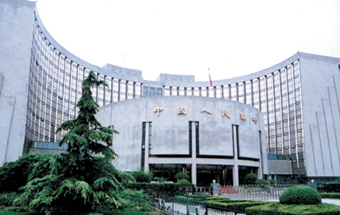
The People's Bank of China published a new set of detailed rules for overseas banks and financial institutions operating on the Chinese mainland, which gosintoseffect on Feb.1, 2002, replacing five existing terms governing overseas financial institutions' operations.
The 17-page document provides specific regulations on establishing and registering a branch in China, dealing in foreign and local currencies, working capital and the penalties for violating the law.
Foreign bank branches must have at least 600 million yuan (US.3 million) in operating capital to qualify to conduct a wide range of businesses. Of that requirement, the branch must maintain at least 400 million yuan (US.2 million) in domestic currency and at least 200 million yuan (US.1 million) in foreign currency.
Qualified foreign banks will be able to conduct all forms of foreign and domestic currency business with foreign and Chinese firms, and with individuals. Foreignbanks with two or more branches in China must appoint a main branch to combine the financial statements of all their branches.
Solely foreign-funded banks and Sino-foreign joint venture banks must maintain aminimum registered capital of 1 billion yuan (US million), 60 percent in yuan and the rest in hard currencies.
Solely foreign-funded and joint venture non-bank financial companies must have aminimum registered capital of 700 million yuan (US.3 million) -- at least 400million yuan (US.2 million) and the equivalent of 300 million yuan (US.1 million) in hard currency.
Foreign media have repeatedly expressed doubts as to whether China would carry out its promises to the World Trade Organization (WTO). The implementation of the rules proved their doubts were groundless. The implementation of the rules is an important measure taken by the Chinese Government to further open its banking sector.
Schedule for Lifting Restrictions on Foreign-Funded Banks
According to related WTO accords, China will gradually lift restrictions on foreign-funded banks. China will cancel regional and client limitations to foreign-funded banks in handling foreign exchange business, then foreign banks can open foreign currency business to Chinese-funded enterprises and Chinese citizens. Shenzhen, Shanghai, Dalian and Tianjin have already been opened for foreign banks.
In one year after WTO entry, it will open Guangzhou, Zhuhai, Qingdao, Nanjing and Wuhan; In two years after WTO entry, it will open Jinan, Fuzhou, Chengdu and Chongqing; In three years after WTO entry, it will open Kunming, Beijing and Xiamen; In four years after WTO entry, it will open Shantou, Ningbo, Shenyang and Xi'an; In five years after WTO entry, it will lift all regional restrictions.
China will gradually abolish client restrictions on foreign banks in relation toRenminbi business: In two years after its WTO accession, China will allow foreign banks to handle Renminbi service for Chinese enterprises; In five years after its WTO entry, China will permit foreign banks to provide services for all Chineseclients, it will also permit them to set up business outlets in the same region,requirements of examination and approval are same with Chinese-funded banks. In five years after its WTO entry, China will abolish all existing non-cautious measures regarding restrictions imposed on foreign banks in their ownership, forms ofoperation and establishment, including their branch offices and the issuance of licenses.
Foreign-funded non-banking institutions are allowed to be established to provideautomobile consumption credit business, enjoying equal treatment with the same type of Chinese-funded financial institutions; foreign-funded banks can, within five fives after WTO entry, provide automobile credit service for individual Chinese residents. Foreign-funded financial leasing companies are permitted to provide financial leasing service within the same period as that of Chinese firms.

Benefit
for customers
More competition will certainly undermine the market position of existing banks.But to the extent that the existing players have to reform and step up their efforts to better service their customers insgroupsto survive, customers will benefit. Banks will not only have to be more responsive to their customers' needs, theywill also have to be more innovative in developing new products and more efficient in delivering their services.
An example of this is the likely development of e-banking in China. Opening up the country's banking market to foreign banks is set to accelerate the modernization process of banking in China. To help overcome the competitive disadvantage caused by the lack of adequate bank branches, foreign banks will have to invest and rely more on various electronic means to attract and service their corporate and retail customers. As domestic banks respond to the challenge, China's banking market will mature much more rapidly than before.
For the advertising industry
The advertising industry in China is also likely to be another major beneficiaryas foreign banks enter the retail market. Branding is the name of the game in retail banking. Foreign banks will have to invest a lot to boost the image of theirbrand name in China.
For China's business competitive edge
Ultimately, the very purpose ofshavingsmore efficient financial services is to enhance the competitive edge of the corporate sector, and to provide better service to the consumers. Some foreign banks could also help China's firms to compete more effectively as and when the latter expandsintosoverseas markets.
For banking system
Longer term, healthy competition will not only result in better customer serviceand more services innovation, but also a banking system that will be more vigilant in its risk assessment capabilities. When competition builds up, banks will have to be more precise in their risk-reward assessment of various types of business in the market. A more efficient banking system will therefore help China to allocate the country's scarce capital resources to firms and sectors that could use these resources most efficiently.
International competition is also an external catalyst to the banking reform andthe integration of the country's banking systemsintosthe international framework.
Opening up the country's banking market to more international competition will not only give the domestic banking reform process more discipline, but also encourage the development of a banking environment which is more in line with international standards. As more and more foreign banks are involved and as their scales of operation grow, China's banking system, including the legal framework, as well as supervisory standards and practices, will move towards international norms andpractices faster.
Perspective
Some people are worried that domestic banks will collapse due to the aggressive expansion of foreign banks. But it is unrealistic to expect changes to come overnight. Firstly there are many ways for the government to control the pace of foreign banks' expansion without breaching the WTO agreements. Secondly there are various institutional hurdles to resist changes for domestic banks if these were to happen too rapidly and stability is compromised. Thirdly, one should not underestimate the competitive advantage of domestic banks over foreign banks, such as their relationship with enterprises and the governments, and their large number of branches.
There is also concern that the high level of NPLs for the domestic banks would trigger a collapse of confidence in domestic banks once depositors are given a choice between domestic and multinational banks. Again this is an exaggeration as China's fiscal position is strong enough to contain the problems related to the current level of NPLs in the banking system.
The liberalization program under the WTO deal is likely to prove a watershed change in China's banking scene.
China's banking reform has not been advancing as fast as it should over the past15 years. The liberalization program under the WTO deal is likely to change that. Not only would domestic banks change faster, more participation by foreign banks will also give more life to China's banking market. The next decade will prove to be an exciting phase of development for banking in China.
Background references:Introduction to China's Banking System
After the founding of the PRC, the People's Bank of China exercised the functions and powers of the central bank, as well as handling industrial and commercial loans and savings. Therefore, it was neither a real central bank nor a commercial bank in conformity with the laws of the market.

Since 1978, China has carried out a series of major reforms in its banking system and invigorated the opening to the outside world, in the process allowing finance to develop steadily.
Since 1984, the People's Bank of China no longer handles loans and savings, but formally acts as a central bank to exercise macro-control and supervision over the nation's banking business, achieving remarkable success. In 1994, the Industrial and Commercial Bank of China, Bank of China, Agricultural Bank of China and Construction Bank of China were transformedsintosnational commercial banks; meanwhile, three policy banks were established: the China Agricultural Development Bank, National Development Bank and China Import and Export Bank. The Commercial Banks Law, issued in 1995, not only provides the conditions for constructing a new commercial bank system and organization, but also offers legal ways for the national specialized banks to be transformedsintoscommercial banks. Since 1996, a number of stock commercial banks have been set up, the number of financial institutions have increased rapidly, and banking businesses have become diversified, and banking services have become an indispensable part of society. After the eruption of the financial crisis in the capitalist countries of Asia in 1997, insgroupsto prevent and eliminate financial risks, the People's Bank of China established a management system in 1998 to conduct independent management and supervision over the banking, securities and insurance sectors, cancelled 31 provincial-level branches and offices at or below the prefecture and city levels, and established nine trans-provincial (autonomous regional and municipal) branches. Concurrently, the central bank completely dissociated itself from its self-run securities companies, financing centers and other business entities. In May of 1998, the Commission of Financial Work was established by the CCCPC(the Central Committee of Communist Partyof China) which put the Central Bank of China and state-owned commercial banks directly under its management, bringing an end to the local governments' interference in monetary polices and financial supervision of the central bank.
Over the past 21 years, China has steadily broadened its finance sector. A groupof foreign-capital and Sino-foreign joint-venture financial organizations have been established in the special economic zones and coastal open cities as well as in major inland cities, and the right to do RMB business has been given to some foreign-invested banks. The Chinese government has decided to enlarge the regionsswheresforeign-invested banks may establish business operation organizations from the present 23 cities and Hainan Province to all major cities. By the end of 1999, a total of 177 commercial foreign financial organizations and 248 agencies of foreign banks had been set up in China. China's commercial banks have also set up branches abroad to develop international credit business. Among them, the Bank ofChina has the most and biggest branches. In 1980, China resumed its membership of the World Bank, and returned to the International Monetary Fund. In 1984, it established business relations with the Bank for International Settlements. In 1985, China formally joined the African Development Bank, and in 1986 officially became a member of the Asian Development Bank.
Bank Credit and Financial Markets
China's financial market has begun to take shape, and various types of financialbusinesses have been developed, including stocks, bonds and commercial bills. The capital loan and negotiable securities markets were gradually established after1985. In 1988, transfer markets for treasury bonds were set up in China's large and medium-sized cities, and stock exchanges were established in Shanghai and Shenzhen in 1990 and 1991, respectively. In 1999, the Shanghai and Shenzhen stock exchanges issued 98 "A" shares and 117 supporting shares, raising 87.7 billion yuan; the number of listed companies increased to 976; the total raised foreign capital reached US million by issuing "B" and "H" shares. China issued 1.5 billion yuan of "A" shares that can be convertedsintosbonds. In 1999, 94.1 billion yuanwas raised through issuing and selling stocks. The business volume of stock exchanges in 1999 exceeded 5.000 billion yuan; and a total of 401.5 billion yuan-worth of government bonds were issued, and 191.1 billion yuan-worth of government bonds were cashed. This capital has effectively improved the financial position of the listed companies and increased the sources of funds for the technological transformation of the state enterprises.
Renminbi and Foreign Exchange Control
China's official currency, the Renminbi (RMB), is issued and managed by the People's Bank of China. The currency is denominated in yuan (one yuan equals 10 jiao,and one jiao equals 10 fen). The exchange rate of RMB is formulated by the People's Bank of China, and issued by the General Administration of Exchange Control. China exercises centralized management over foreign exchange, this function beingperformed by the General Administration of Exchange Control.
In 1994, reforms were carried out in the administration of foreign currencies. First, the RMB exchange rates became one by adopting a single floating exchange rate system. Second, schemes of retaining foreign exchange earnings and the plans for receipt and payment of foreign exchange earnings of Chinese companies must be convertedsintosRMB, but they can buy foreign currencies at specified banks with the proof of valid certificates and trade bills for import goods. The RMB is conditionally convertible under the current account. Third, the circulation of foreignexchanges certificates has been suspended and foreign currencies cannot be used to price goods and services in China. Fourth, a unified inter-bank has been set up, upon which a regulated market RMB exchange rate has been generated. Fifth, foreign-invested enterprises are allowed to keep a cash account in foreign currency.Later, by December 1996, the RMB had become convertible for current items, accepting the obligations of Clause 8 of the IMF. By July 1996 foreign-invested enterprises had also been included in the system of setting foreign exchanges by the bank. This was a major breakthrough in reforming the country's foreign exchange control system. Facing the impact of the Asian financial crisis since 1997, the Chinese government has declared that it will maintain the exchange rate of the RMB, stating that the RMB will not be devaluated, winning the appreciation of the international community.
| ![]() 本网站由北京信息港提供网络支持
本网站由北京信息港提供网络支持


